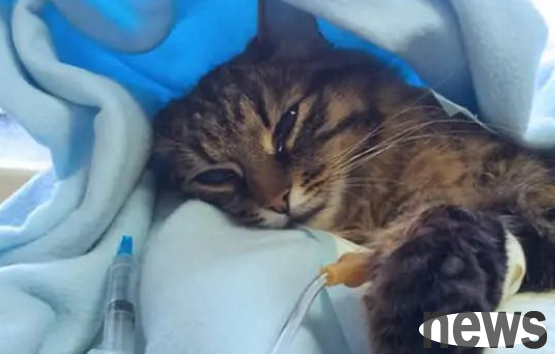Which pet owner doesn't want to get a healthy baby? Is the curse of "Animals of the Week" really impossible to break?
Buy/adopt a new cat, how can you predict and intervene in advance before the cat becomes ill?
Today, let’s talk about what “week cat” is and how to avoid the tragedy of “week cat”.
Weekly cats
refers to pet cats who start to develop illness in about a week after being bought by their pet owners and are unable to rescue them and have a very short survival time.

1. What diseases cause weekly cats?
1.Female plague virus
is also known as "feet panleoleocytopenia". Kittens can obtain migration antibodies from breast milk, which disappear from about 45 days.
Symptoms: vomiting, diarrhea, fever, loss of appetite, and mental depression. After infection, the rapidly disappearing white blood cells, dehydration caused by vomiting and diarrhea, and high fever can be killed.
In other words: The kitten is facing the most dangerous situation during the cutest period.
Inspection method: The test can be performed through the cat plague-specific antigen test plate, and the blood routine results are used as reference.
2. Herpes virus
cat nasal bronchitis virus, commonly known as "nose branch". In severe cases, acute death in kittens are likely to occur.
Symptoms: fever, poor breathing, excessive secretions in the eyes and nose, sneezing, and loss of appetite.
This virus is once infected for life, but there is a "quiescent period" and a "active period". The symptoms appear during the active period, and the symptoms do not appear during the quiescent period and cannot be detected.
Collective outbreak: When 10% of individuals in a cat group begin to enter the active replication period of viruses, it will trigger a major outbreak in more than 50% of individuals within one week.
Cold temperature outbreak: Virus reproduction will intensify when the temperature drops.
Detection method: Testing and treatment are only meaningful when symptoms appear. Recommended: PCR.
3. Intestinal parasites - Trichomonas and coccidiosis
Diarrhea from unknown causes is often related to Trichomonas and coccidiosis.
These two types of parasites belong to protozoa. Conventional antiworming drugs cannot be prevented in advance and are very likely to be infected through cat litter boxes and daily necessities. It is common in cathouses/multi-cat environments, and stray cats and domestic cats are not easily infected. After infection, continuous diarrhea or occasional constipation will cause many owners to mistakenly believe that cats are intolerable to food. In addition, the random detection rate is not high, and many cats are still suffering from harm until they are half a year old.
Individuals infected with intestinal parasites are like a pool that stores water and pumps water.
When a cat is very small, it is easy to cause bloody stools caused by inability to die from diarrhea, weight loss and dehydration + unabsorbed nutrition.
detection method: It is routine and can be repeated multiple times.
4. The mastermind behind the scenes - the "death" of cats during white blood and AIDS
weekly cats are usually not directly caused by these two diseases, but they can be said to be the second biggest thrust behind the scenes, because:
infection with the feline leukemia virus may cause abnormal coagulation function or other blood diseases (regenerative/non-regenerative anemia), immune-mediated diseases, etc. (most of them may eventually die due to immunosuppression);
cat AIDS, i.e. cat immunodeficiency disease, in addition to the main attack on the immune system and the loss of effectiveness of the injected vaccine, may also cause symptoms such as fever, mental depression, gastrointestinal/respiratory tract, expand the adverse effects of other diseases, and continue to "add debuff" to the body.
Cat leukemia virus is also known as "cat-friendly" disease and is mostly transmitted through saliva licking, so it is possible for a group to live (multiple cat families, cathouses);
On the contrary, the main transmission method of cat AIDS is biting, and stray (male) cats have the highest risk of onset.
In short, the two are spread in different multi-cat families, cathouses, and stray cat environments, reducing cat immunity, interfering with vaccine effectiveness, and expanding the adverse effects of other diseases on the body.
Detection method: Use a detection plate to perform leukemia antigen, AIDS antibody testing, or PCR testing on peripheral blood (time and cost-effective, usually used for re-examination of suspected cases).

2. Where does the cat come from during the week?
The current channels for cat harvesters that pet owners can access, whether it is the "regular cathouse" praised in the third person, the despicable "backyard breeding", or the seemingly reasonable "family breeding", for cats, they are all a large group environment.
The possible disadvantages of these environments are:
There are many cats, the environment is closed and the space is insufficient; the immune status of individuals is complex; the parasites cannot be checked in detail; the potential viruses carried by individuals are unknown;
In other words, kittens that have not undergone a comprehensive physical examination are themselves full of uncertainties. Every one you buy home may become a week cat.
Is it possible that the one I picked up in the grass is a week cat?
The answer is: Yes!
However, Chinese pastoral cats have been naturally eliminated by harsh environments, and most of the surviving individuals have good physical fitness. However, relatively speaking, individuals who have "never drunk breast milk since childhood/weaned too early" are more likely to be threatened.
3. How to avoid cat tragedy happening on weekdays
When choosing a cat,
Q1: How to choose a cathouse?
Can watch cathouses with videos, long-term and continuous observations are the best;
Tits with single breeds are better than cathouses with multiple breeds;
Tits with small populations are better than those with large numbers;
Individual immunity is completely better than those with lack of immunity;
Tits with good reputation are better than those with no understanding at all.
Q2: How to choose a kitten from a cathouse?
Check out the video information of different platforms of the cathouse (moments, Weibo, etc.) to see if the cathouse has "sneezing" (it is likely to suffer from herpes virus); whether there is soft stool in the cathouse; whether the group has regular immunity records.
Try to choose individuals with complete immunity, normal bowel movements, no sneezing, no secretions from eyes and nose, good appetite and good spirits.
Q3: When can I pick it up?
If you like cuteness, take it away at any time. ×
You must be vaccinated before you can get home. √
Note: The vaccine is finished and effective, not just 3 shots!
Q4: How to identify whether there are any hidden viruses in cathouses?
cannot be identified, animals that are not in the active stage of the virus cannot be detected, and the probability of future disease cannot be tracked and investigated. (such as FIP induced by coronavirus)
Q5: In addition to buying cats, where is the best place to get cats?
It is recommended to go to the grass and take a look, pick one up by others.
It is not recommended to buy "consigned cats" that you have never seen before from the Flower, Bird and Fish Market/WeChat/Taobao/58.com/roadside cat dealers! The probability of "collecting money to block", "having illness at home" and "inconsistent pictures and texts" is extremely high.
If a new kitten experiences abnormalities, such as sneezing, not eating, listlessness, and diarrhea, it is recommended to take it to the hospital for a comprehensive physical examination as soon as possible.
If everything is normal, you can first keep it at home for 2 weeks.
When taking the unimmunized kitten to the hospital, explain the situation to the doctor, and after contacting other kittens, use hand sanitizer to wash your hands thoroughly.